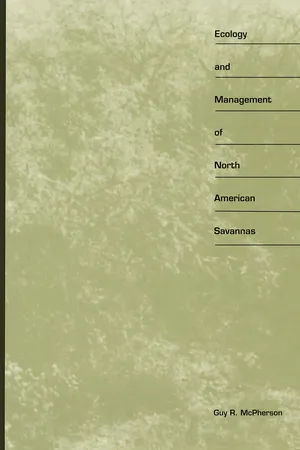
- 224 pages
- English
- PDF
- Available on iOS & Android
eBook - PDF
Ecology and Management of North American Savannas
About this book
Savannas are ecosytems with a continuous grass layer and scattered trees or shrubs. These lands occupy nearly a third of the earth's land surface and are an important resource not only in world economies but also as repositories of biodiversity. Because savannas are generally thought of as tropical ecosystems, most reviews of the literature have tended to disregard savannas found in temperate zones. Yet these ecosystems are both extensive and diverse in North America, ranging from longleaf pine habitats along the Atlantic coastal plain to xeric piñon-juniper communities of the Great Basin-ecosystems seemingly disparate, yet similar enough to merit study as savannas. This book provides an overview of the patterns and processes shared by these ecosystems and offers substantive ideas regarding future management and research efforts. It describes the composition geographic distribution, climate, soils, and uses of savannas throughout North America, summarizing and integrating a wide array of literature. While discussing these ecological patterns and processes. McPherson develops a framework for implementing management practices and safeguarding the future of these important wildland ecosystems. Ecology and Management of North American Savannas takes a major step toward establishing the science of savanna ecology for North America. It encourages constructive debate and relevant research on these important systems and will also serve as a useful resource in biogeography, plant ecology, and rangeland management.
Frequently asked questions
Yes, you can cancel anytime from the Subscription tab in your account settings on the Perlego website. Your subscription will stay active until the end of your current billing period. Learn how to cancel your subscription.
At the moment all of our mobile-responsive ePub books are available to download via the app. Most of our PDFs are also available to download and we're working on making the final remaining ones downloadable now. Learn more here.
Perlego offers two plans: Essential and Complete
- Essential is ideal for learners and professionals who enjoy exploring a wide range of subjects. Access the Essential Library with 800,000+ trusted titles and best-sellers across business, personal growth, and the humanities. Includes unlimited reading time and Standard Read Aloud voice.
- Complete: Perfect for advanced learners and researchers needing full, unrestricted access. Unlock 1.4M+ books across hundreds of subjects, including academic and specialized titles. The Complete Plan also includes advanced features like Premium Read Aloud and Research Assistant.
We are an online textbook subscription service, where you can get access to an entire online library for less than the price of a single book per month. With over 1 million books across 1000+ topics, we’ve got you covered! Learn more here.
Look out for the read-aloud symbol on your next book to see if you can listen to it. The read-aloud tool reads text aloud for you, highlighting the text as it is being read. You can pause it, speed it up and slow it down. Learn more here.
Yes! You can use the Perlego app on both iOS or Android devices to read anytime, anywhere — even offline. Perfect for commutes or when you’re on the go.
Please note we cannot support devices running on iOS 13 and Android 7 or earlier. Learn more about using the app.
Please note we cannot support devices running on iOS 13 and Android 7 or earlier. Learn more about using the app.
Yes, you can access Ecology and Management of North American Savannas by Guy R. McPherson in PDF and/or ePUB format, as well as other popular books in Biological Sciences & Environmental Science. We have over one million books available in our catalogue for you to explore.
Information
Table of contents
- Contents
- List of Illustrations
- Preface
- Acknowledgments
- 1. Importance and Extent
- 2. Overstory-Understory Interactions
- 3. Savanna Genesis and Maintenance
- 4. Historical Changes
- 5. Expected Future Changes
- 6. Applying Ecological Knowledge
- 7. Research Needs
- Appendix of Scientific and Common Plant Names
- Literature Cited
- Index